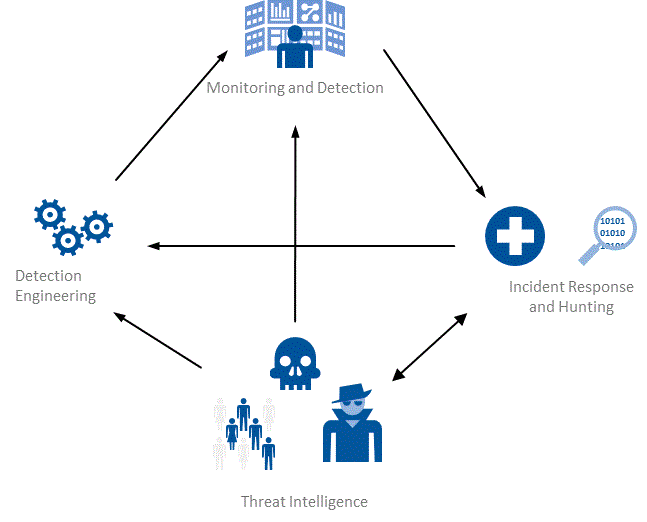You want the best security for your business, but with so many SOC models to choose from, how do you select the right one? Staying up-to-date and informed on all the different Security Operations Center models available will help you make the right choice for your organization’s needs.
Understanding Security Operations Center

Security Operations Centers are dedicated teams of information security professionals responsible for understanding, detecting, responding, and reporting on security threats. A well-run SOC can provide the organizational resilience required to quickly detect and respond to a wide range of cyber-attacks.
When it comes to implementing security operation services, there are multiple models that need to be considered.
-
Outsourcing/Managed Service Provider – MSP
This model involves outsourcing your security operations tasks to a third-party service provider. This can range from completely outsourced services with all analysis conducted externally or hybrid models where certain tasks are performed by in-house personnel.
-
In-house/Organisation Model – IOM
An in-house SOC is when an organization builds its own team, resources, and processes for managing its cyber security program internally. This provides more control over how resources are employed but requires additional effort including training personnel, evaluating solutions, and increasing staff over time as the threat landscape changes.
-
Co-sourcing Model – CSM
This model is when an organization takes advantage of both external services provided by an MSP/consultant while using their own internal resources such as personnel or tools like SIEMs or IDS/IPS systems. It can involve either leveraging external support only during peak periods or engaging them periodically for specific tasks like an incident response or vulnerability management while still maintaining responsibility in-house overall.
• Virtual Security Operations Center (VSOC):
VSOC is an outsourced service where firewalls, routers, and other network devices are monitored remotely by remote operators or automated systems located offsite from one or more locations. This model can help cut costs associated with staffing onsite personnel and provide access to experts available 24/7 at reduced costs compared to traditional SOCs.
Considerations for Choosing the Right Model

Choosing the right security operations center model for your organization can be a challenging task. To make the decision successfully, you need to take into account a number of factors related to the type and size of your organization, as well as its specific needs, budget, and resources. Here are some key considerations to help you select the SOC model that is best suited for your needs:
Business size and scope
The size and scope of an organization have a direct impact on which SOC model it should choose. For smaller organizations, less complex approaches like managed services may be ideal, while larger organizations can use more sophisticated solutions such as integrated solutions or virtual SOCs which allow teams to work together remotely across boundaries.
Resource availability
Before deciding on a particular model, you should assess the resources available in-house to support it. For example, if there is limited in-house technical expertise available then managed services may be preferable as they manage security activities on behalf of customers with no in-house expertise required from their side.
Regulatory compliance requirements
Organizations must determine what compliance requirements are applicable to their industry or sector before selecting a solution, as not all solutions may meet these requirements. If regulatory or industry compliance is required then an integrated or virtual solution may be needed so that accurate records can be maintained and auditing capabilities incorporated where needed.
Budgetary parameters
The cost associated with different types of SOC models can vary significantly depending on resource availability and scalability options needed in order to accommodate increased demand down the line; thus organizations need to consider their budgetary parameters before selecting a particular implementation approach. Managed services tend to have lower upfront costs but higher ongoing costs; virtual and integrated models typically have higher upfront costs but provide long-term cost savings due to the flexibility and scalability options present in these models.
Benefits of the SOC Model

The benefits of deploying a SOC model include:
– Improved threat detection: By utilizing sophisticated analytics and machine learning technologies, a well-designed SOC can detect anomalies within an organization’s systems before they become an issue. This early detection helps to prevent catastrophic incidents or data breaches.
– Increased incident response times: A SOC is designed to quickly identify suspicious activity within an organization’s system so the appropriate teams can take corrective action quickly. This reduces the amount of time it takes to resolve incidents from days down to minutes or hours.
– Enhanced security posture: By providing visibility across all points in the network, as well as detailed reporting capabilities, a SOC reduces the risks associated with running critical networks, allowing organizations to better prepare for future threats.
– Improved operational efficiency: Automation is a key component of a well-designed SOC which helps reduce the resources required to actively monitor assets in near real-time. Automation also allows organizations more time to focus on strategy and innovation rather than mundane tasks such as tuning false positives or responding to common alerts.
Implementing the Right SOC Model

Choosing the right Security Operations Center model for your organization requires careful consideration of multiple components. While there are many factors to consider, two primary aspects – deployment type and coverage level – should be addressed when deciding on an SOC model to implement.
Deayment type refers to how resources are being used within the SOC. Organizations can either opt for an in-house SOC, a Managed Security Service Provider (MSSP), or a hybrid approach that combines aspects of both in-house and outsourced solutions.
Coverage level refers to the range of capabilities offered by an SOC model, including system support operations such as security event log monitoring, malware analysis and incident investigation as well as proactive services such as patch management and vulnerability assessments. The coverage level should align with you organization’s security requirements, budget constraints and industry standards for compliance. There are several levels to consider – basic coverage which is ideal for small organizations; standard coverage which often includes 24/7 monitoring; advanced coverage which encompasses more complex technologies; and extended coverage which typically meets sophisticated organizational needs requiring specialized skillsets .
Conclusion
The process of selecting from among the various SOC models is complex. However, when you have a thorough understanding of your organization’s network environment, security posture, and marketplace landscape, choosing the right model should become much simpler.
Ultimately it comes down to finding the best balance between protecting your information and not overspending on security measures. Armed with these tools and insights, you can make an educated decision concerning the right model for your organization, and move forward with confidence in your security posture.









